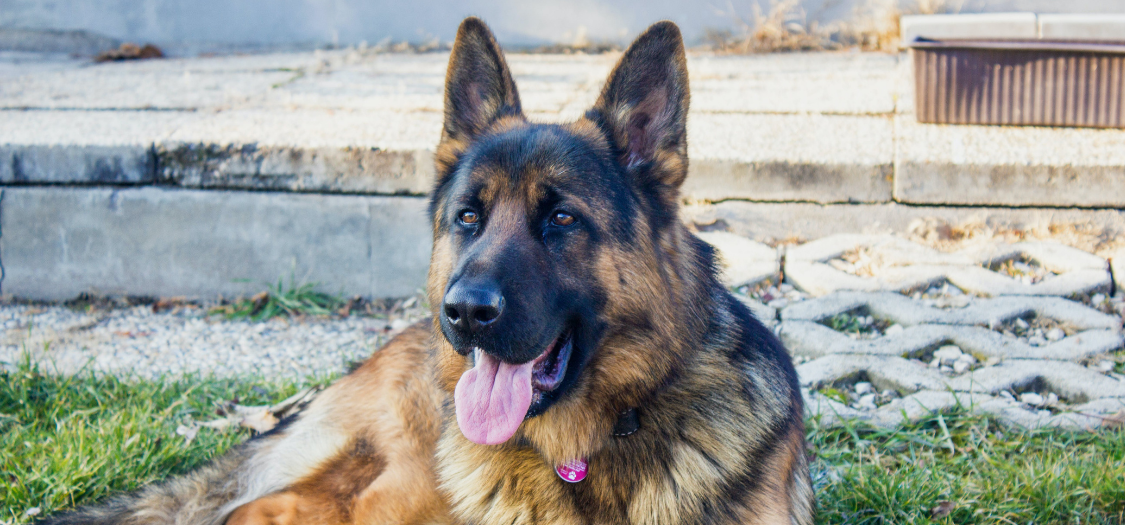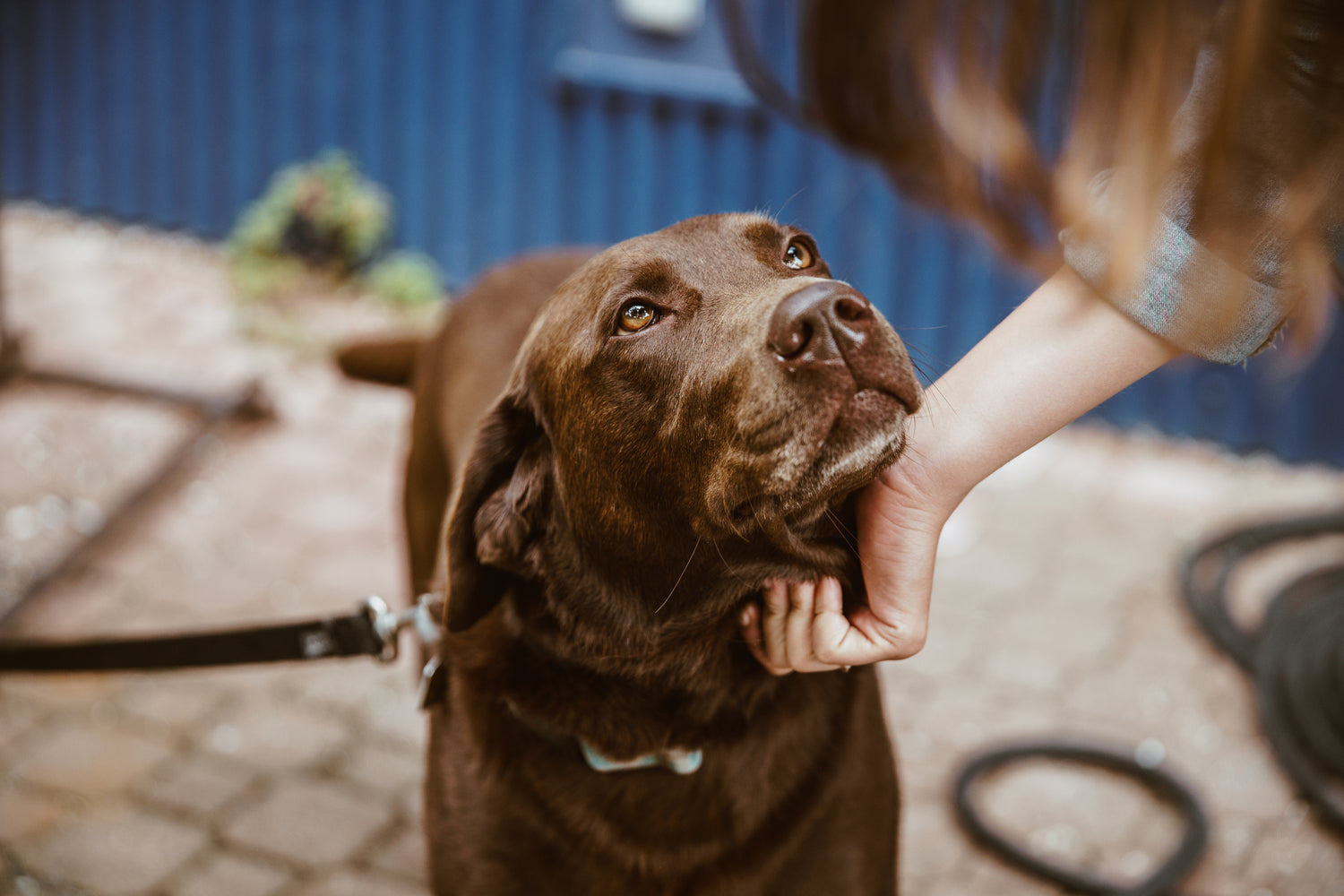Does My Dog Have Hip Dysplasia?
What Should I Do?

Hip dysplasia in a dog happens where there’s an abnormality in the hip joint, and instability in the hip joint(s) biomechanics.
The ‘ball’ at the top of the thigh (femur) doesn’t sit well in the socket of the hip joint. This might be because the ‘ball’ at the top of the thighbone is misshapen. Alternatively, the hip socket, in which the ‘ball’ sits, can be too shallow or deformed. The ligaments of the hip joint are also likely too lax (loose).

Whereas normally the bones of the hip joint glide smoothly against each other, the instability in these scenarios causes rubbing of the hip joint bones in the wrong places in the joint. This rubbing causes pain, inflammation, degeneration of the hip cartilage, microfracturing of bones surfaces, and ultimately osteoarthritis.
It’s a very painful, common orthopaedic condition. ‘Dysplasia’ means ‘abnormality of development’. Hip dysplasia is an inherited condition. Some breeds are more vulnerable to it than others - e.g. rapidly growing large breeds. However, any dog - pure or mixed breed - can develop it.
When there are abnormalities in the hip joint bones (i.e. the hip socket might be too shallow or the ‘ball’ of the femur isn't fully formed), it’s thought that these abnormalities form during a puppy’s most rapid growth phase, between 14 and 26 weeks of age. However, it’s usual for symptoms to present, and a diagnosis to be made, when a puppy’s between 6-12 months of age.

Symptoms of hip dysplasia in a dog who’s suffering from a mild form of hip dysplasia may not show until they’re an adult dog, and have developed arthritis of the hips (usually a secondary condition i.e. because of the hip dysplasia).
Hip dysplasia in dogs is a multifactorial condition. This means whether or not it develops is influenced by a combination of genetic and environmental factors. Some of the main causes and contributing factors to hip dysplasia are:
Genetics play a significant role in the development of hip dysplasia in dogs. Dogs with a family history of the condition are more likely to inherit the genes which predispose them to hip dysplasia. Currently it’s estimated that there are roughly 100 gene codes for hip dysplasia. Pure breeds are more likely than mixed breed dogs to develop it, although mixed breed dogs with purebred parents are at risk too. Breeds such as Labrador Retrievers, Golden Retrievers, German Shepherds, and Rottweilers are known to have a higher prevalence of hip dsyplasia.
This means that the shape of parts of the skeleton aren’t well developed. Dogs with poor hip joint conformation might have shallow hip sockets or badly formed ‘balls’ at the end of their thigh (femur) bones, for example. Dogs with poor hip joint conformation are more prone to hip dysplasia. This poor conformation might be a result of genetic factors, or developmental abnormalities during growth.
Puppies that grow too fast can exacerbate their risk of developing hip dysplasia. Large and giant breed puppies can be prone to rapid growth, which can stress developing joints, and cause poor conformation. Both of these factors can increase the likelihood of hip dysplasia.
Inappropriate nutrition, including overfeeding, or a diet lacking the essential nutrients for bone and joint health (e.g. an imbalance of calcium and phosphorous) can contribute to the development of hip dysplasia. Excess weight gain can also exacerbate symptoms in dogs already predisposed to the condition.
Although not all vets agree with this theory, it’s thought that overexertion, and in particular high impact activities, can contribute to joint and ligament laxity and increase the risk of hip dysplasia. Make sure your puppy or young dog engages in appropriate, low-impact exercise to promote healthy joint development.
Hormonal imbalances, such as abnormal levels of estrogen or testosterone, can affect skeletal development and ligament laxity, and increase the risk of hip dysplasia.
Slippery surfaces at home (e.g. wooden or tiled floors), or inadequate bedding, can contribute to the development or progression of hip dysplasia. This is because both put additional stress on the joints.
Excessive weight gain in puppies can contribute to the development of hip dysplasia. This is particularly relevant for large and giant breeds, as rapid growth can outpace the development of the joint structures.
While hip dysplasia is often recognised in young dogs, it can also develop or worsen with age, due to the cumulative effects of wear and tear on the joints.

To a certain extent, making the right choices can sometimes affect the rate and severity at which hip dysplasia develops. However, when a dog’s genetically predisposed to developing it, sometimes all the right lifestyle measures in the world still won’t stop it from developing. This is simply because, in the case of a specific dog, it’s sometimes impossible to prevent.
Screening - If you’re thinking of buying a dog, ask to see the hip and elbow scores of both parents. In the UK, a hip score is when the hips have been x-rayed and graded by a panel of expert BVA vets. The lowest score is 0 and the highest is 53 - so for both hips the lowest score possible is 0 and the highest score possible is 106. The lower the score, the better. Parents with poor hip scores are likely to have offspring with joint issues. You should get a puppy with parents who’ve got good scores according to the breed-specific statistics.
Likewise, if you’re thinking about breeding, it’s recommended that you should only breed from parents who’ve both got hip scores below or close to the published breed median.
Control your Puppy’s Rate of Growth - Controlling how fast your puppy grows can mean the difference between them developing hip dysplasia or not. When a puppy grows too fast, it means bones can develop at different rates. If different bones grow at different rates out of sync, that’s when problems occur (such as the ‘ball’ of the thigh bone not fitting properly into the hip socket). So puppies should be fed an appropriate diet and kept at a lean weight during their growing years. Don’t give in to the temptation to overfeed your puppy so that they become ‘big and strong’. Studies have shown that 70% puppies who were overfed then developed hip dysplasia.
Weight Control - From puppy hood onwards, keep your dog at the right weight. A lean dog means that there’s no extra stress or pressure being put on the hip joints. Extra stress on the hip joints is closely connected to the development of hip dysplasia.
Appropriate Exercise - It’s generally understood that overexercising a puppy can lead to hip dysplasia. Not every vet agrees with this theory, citing a lack of evidence to prove it, but what is certain is that exercising your puppy the right amount is important for their health and wellbeing. Ask your vet for guidance on how much exercise your dog needs at each stage of their life, particularly energetic and playful breeds.
Spaying / Neutering - Consider waiting to neuter your dog until they’re fully mature. Evidence suggests that spaying or neutering at a young age might lead to a higher incidence of hip dysplasia. This might be because hormones, or lack of, may influence ligament laxity.
Joint Health Supplements - Joint supplements, particularly those which contain glucosamine, can be used for dogs that are from high-risk breeds as part of a programme to keep joints healthy.
Orthopaedic Bedding - Providing comfortable and supportive bedding helps reduce pressure on joints during rest.
Regular Vet Check-ups - Early detection and intervention can make a significant difference in managing hip dysplasia.
Overall, hip dysplasia in dogs is a complex condition influenced by a combination of genetic predisposition and environmental factors. Responsible breeding, appropriate nutrition, weight control, and careful management of exercise and growth can all help to reduce the risk of your dog developing hip dysplasia, and lessen the severity with which it might develop.
A dog who’s been diagnosed with hip dysplasia will be screened using certain imaging techniques to determine the seriousness of the problem. Once your dog’s vet or orthopaedic specialist has gathered enough information, a treatment plan will then be decided upon. Treatment for hip dysplasia in dogs will either involve surgery or take a conservative management approach - including physiotherapy, weight control, NSAIDS and pain medication, and possibly a hip brace for dogs. Even with surgery, pre- and post-operative care is pretty much identical to the conservative management approach.
If your dog does develop hip dysplasia, Zoomadog has products that can help you manage your dog’s hip dysplasia symptoms. These include:
Using the right strategies to help your dog with hip dysplasia can really help. Even simple changes, like ensuring that your dog’s the right weight or is wearing non-slip socks if you have slippery wooden or tile flooring, can make all the difference to how your dog’s experiencing their hip dysplasia.
What Should I Do?
What Are The First Signs of Hip Dysplasia In Dogs?
What Are The Different Levels of Hip Dysplasia in My Dog?
What Should I Do?
What Should I Do?
For Hip Dysplasia For A Dog?
What Should I Do?
My Dog Has Very Bad Arthritis In His Hips. What Should I Do?
What Happens, Is It Successful, What I Should Know?
My Dog Is Too Old / Too Risky For Hip Dysplasia Surgery. What Are The Non-Surgical Options?
Can Physiotherapy and Hydrotherapy Help my Dog with Hip Dysplasia?
My Elderly Labrador has Hind Leg Hip Weakness. Does He Have Hip Dysplasia?
I Have a 13-year-old Border Collie with Hip Dysplasia in his Rear Right Hip. What Should I Do?
with Hip Dysplasia

We can help find the right solution for your dog
Feel free to give us a call on 01730 622544
or email us at woof@zoomadog.co.uk
Leave a comment